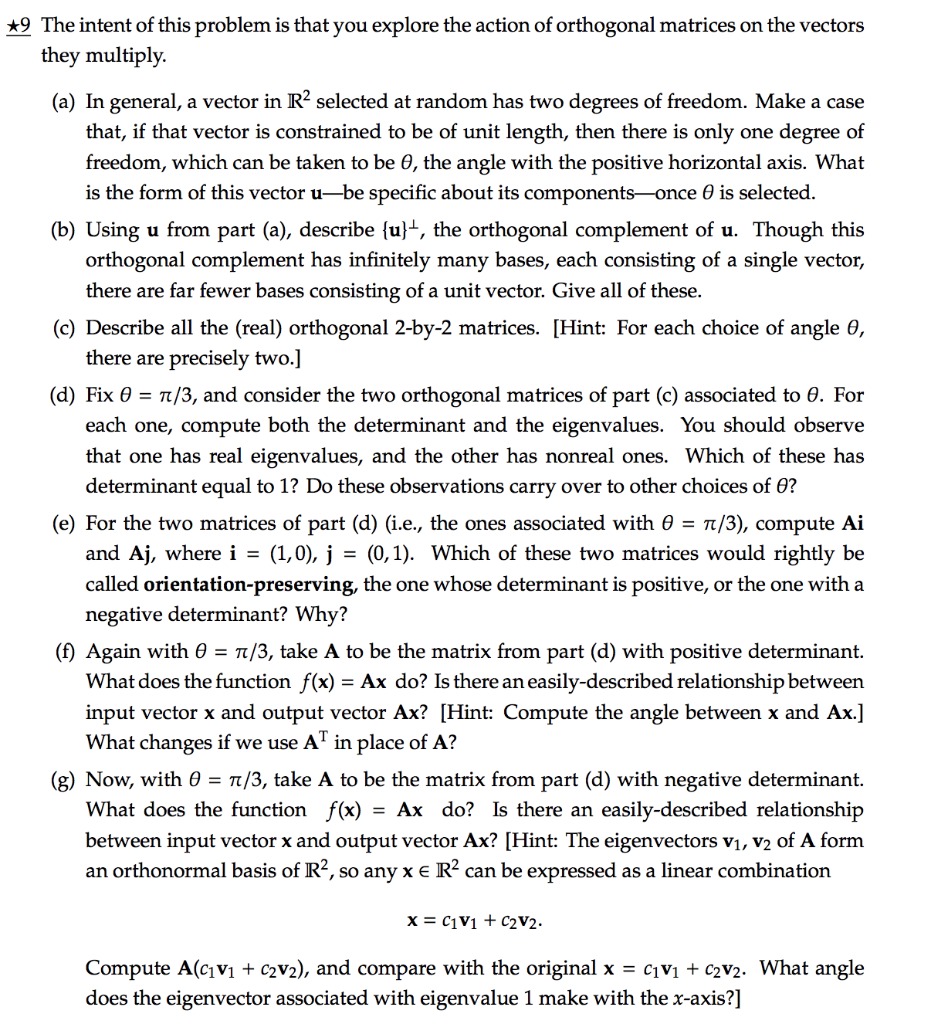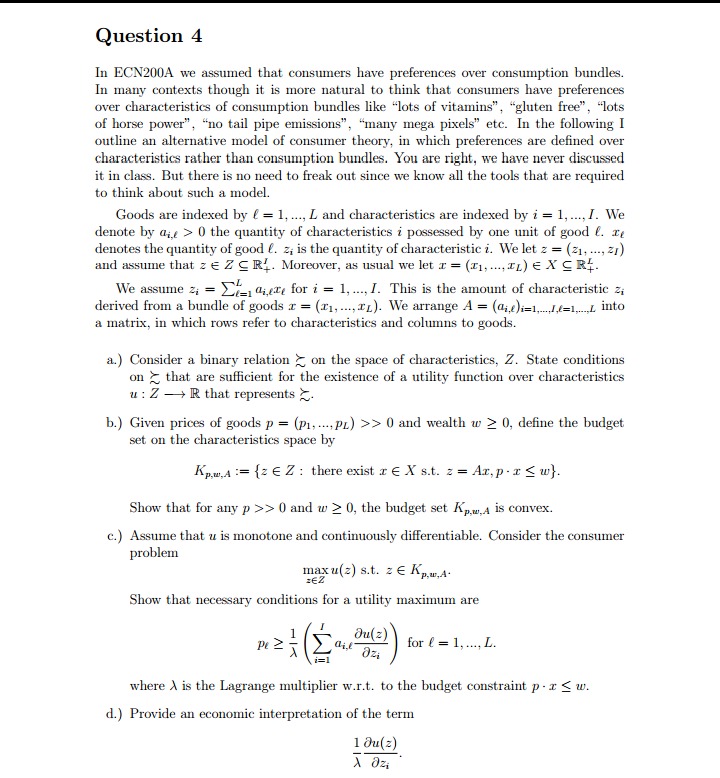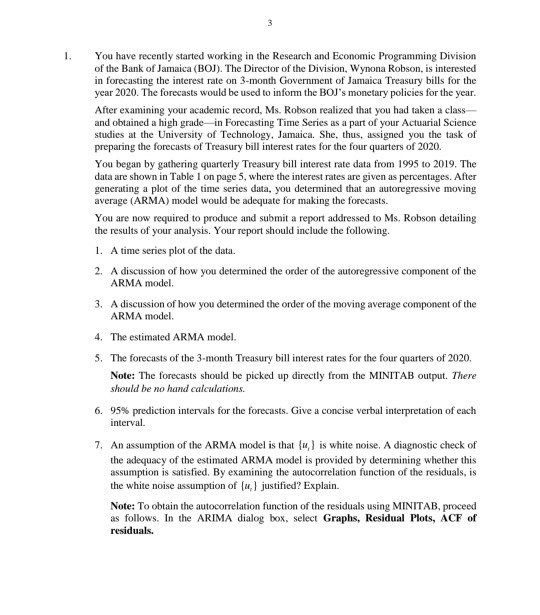



Solve the following .questions as attached below.
*_9 The intent of this problem is that you explore the action of orthogonal matrices on the vectors the}r multiply. (a) In general, a vector in R2 selected at random has two degrees of freedom. Make a case that, if that vector is constrained to be of unit length, then there is only one degree of freedom, which can be taken to be 6, the angle with the positive horizontal axis. What is the form of this vector ube specic about its componentsonce 6 is selected. (b) Using u from part (a), describe [ul the orthogonal complement of 11. Though this orthogonal complement has infinitel}r many bases, each consisting of a single vector, there are far fewer bases consisting of a unit vector. Give all of these. (c) Describe all the (real) orthogonal 2-by2 matrices. [Hintz For each choice of angle 9, there are precisely two.] (d) Fix 6 = f3, and consider the two orthogonal matrices of part (c) associated to 6. For each one, compute both the determinant and the eigenvalues. You should observe that one has real eigenvalues, and the other has nonreal ones. Which of these has determinant equal to 1? Do these observations carry over to other choices of 6? (e) For the two matrices of part (d) tie, the ones associated with 6 = HIS), compute Ai and Aj, where i = (1,0), j = (0,1). Which of these two matrices would rightly be called orientation-preserving, the one whose determinant is positive, or the one with a negative determinant? My? (f) Again with 6 = 11/3, take A to be the matrix from part (d) with positive determinant. What does the function x) = A): do? Is thereaneasily-described relationship between input vector x and output vector Ax? [I-Iint: Compute the angle between x and Ax] What changes if we use AT in place of A? (g) Now, with 9 = 1r! 3, take A to be the matrix from part (:1) with negative determinant. What does the function f(x) = Ax do? Is there an easily-described relationship between input vector x and output vector Ax? [Hint The eigenvectors v1, V2 of A form an orthonormal basis of IRZ, so any x E R2 can be expressed as a linear combination X = $1171 + C2V2. Compute A(c1v1 + czvz), and compare with the original 1: = clvl + czvz. What angle does the eigenvector associated with eigenvalue 1 make with the x-axis?] Question 4 In ECN200A we assumed that consumers have preferences over consumption bundles. In many contexts though it is more natural to think that consumers have preferences over characteristics of consumption bundles like "lots of vitamins", "gluten free", "lots of horse power", "no tail pipe emissions", "many mega pixels" etc. In the following I outline an alternative model of consumer theory, in which preferences are defined over characteristics rather than consumption bundles. You are right, we have never discussed it in class. But there is no need to freak out since we know all the tools that are required to think about such a model. Goods are indexed by f = 1, ..., L and characteristics are indexed by i = 1, ..., I. We denote by one > 0 the quantity of characteristics i possessed by one unit of good f. If denotes the quantity of good f. z, is the quantity of characteristic i. We let z = (21, ..., 27) and assume that z e Z C R4. Moreover, as usual we let r = (21, .... II) EX CR. We assume 2 = 2_ died for i = 1, ..., I. This is the amount of characteristic z; derived from a bundle of goods I = (11, ..., IL). We arrange A = (ait)izl,..If=1.,L into a matrix, in which rows refer to characteristics and columns to goods. a.) Consider a binary relation _ on the space of characteristics, Z. State conditions on _ that are sufficient for the existence of a utility function over characteristics u : Z - R that represents _. b.) Given prices of goods p = (p1, ....PL) > > 0 and wealth w 2 0, define the budget set on the characteristics space by Kow,A := {= EZ : there exist r ( X s.t. = = Ar, p- r Sw}. Show that for any p > > 0 and w 2 0, the budget set Kpa,A is convex. c.) Assume that u is monotone and continuously differentiable. Consider the consumer problem max u(z) s.t. z E Kpu,A. Show that necessary conditions for a utility maximum are pe 2 du(z) for { = 1, .... L. where A is the Lagrange multiplier w.r.t. to the budget constraint p. r S w. d.) Provide an economic interpretation of the term 1 du(z) A dzi1. You have recently started working in the Research and Economic Programming Division of the Bank of Jamaica (BOJ). The Director of the Division. Wynona Robson. is interested in forecasting the interest rate on 3-month Government of Jamaica Treasury bills for the year 2020. The forecasts would be used to inform the BOJ's monetary policies for the year. After examining your academic record, Ms. Robson realized that you had taken a class- and obtained a high grade-in Forecasting Time Series as a part of your Actuarial Science studies at the University of Technology, Jamaica. She, thus, assigned you the task of preparing the forecasts of Treasury bill interest rates for the four quarters of 2020. You began by gathering quarterly Treasury bill interest rate data from 1995 to 2019, The data are shown in Table I on page 5, where the interest rates are given as percentages. After generating a plot of the time series data, you determined that an autoregressive moving average (ARMA) model would be adequate for making the forecasts. You are now required to produce and submit a report addressed to Ms. Robson detailing the results of your analysis. Your report should include the following. 1. A time series plot of the data. 2. A discussion of how you determined the order of the autoregressive component of the ARMA model. 3. A discussion of how you determined the order of the moving average component of the ARMA model. 4. The estimated ARMA model. 5. The forecasts of the 3-month Treasury bill interest rates for the four quarters of 2020, Note: The forecasts should be picked up directly from the MINITAB output. There should be no hand calculations. 6. 95% prediction intervals for the forecasts. Give a concise verbal interpretation of each interval. 7. An assumption of the ARMA model is that (m, ) is white noise. A diagnostic check of the adequacy of the estimated ARMA model is provided by determining whether this assumption is satisfied. By examining the autocorrelation function of the residuals, is the white noise assumption of {u, } justified? Explain. Note: To obtain the autocorrelation function of the residuals using MINITAB, proceed as follows. In the ARIMA dialog box, select Graphs, Residual Plots, ACF of residuals.3. To slow down transmissions of the viral disea 'lockdown" hence ordering business to shut and the citizens to adhere to limiting physical distancing, but leaving the timing of the lockdown to be decided by the two regional governments of Krona. Assume that both regions have roughly the same population size of 10 million citizens. Region 1 entered lockdown at the beginning of month 3, region 2 entered lockdown at the beginning of month 2. See Next Page The following table shows the cumulative infections and fatalities due to the viral disease over time and the time of the lockdown in each region at the end of each month. Month 1 Month 2 Month 3 Month 4 cases fatalities cases fatalities cases fatalities cases fatalities Region 1 100 3 5000 300 9000 540 15000 900 Region 2 100 5 2200 130 4500 270 5500 330 a) The minister for the economy argues that after both regions entered lockdown, in month 3 the number of cases in region 2 more than doubled, whereas the growth rate is lower in region 1 arguing that the lockdown was not effective in preventing the spread of the disease. Do you agree? Can you provide a better estimate using your knowledge of empirical methods introduced in the module? [word limit 250 words; 8 marks]. b) What kind of data would you prefer to have to estimate the full impact of the lockdowns on infections and fatalities? Explain how this would help to improve your estimate from the previous question. [word limit 200 words; 4 marks]. c) In response to the lockdown the economy in region 1 contracted by $1.1bn, and $1.114bn in region 2. What can we learn from these figures about the statistical value of life? [word limit 100 words; 3 marks]. d) Suppose a vaccine against the disease was available at the beginning of month 1 (and assume it works immediately by protecting the citizens from the disease). 60% of population require the vaccine to stop the disease from spreading. The vaccine is available for $20. Should the government introduce the vaccine? State any assumptions you implicitly make underlying your advice and briefly discuss the limitation of your advice. [word limit 250 words; 5 marks]














